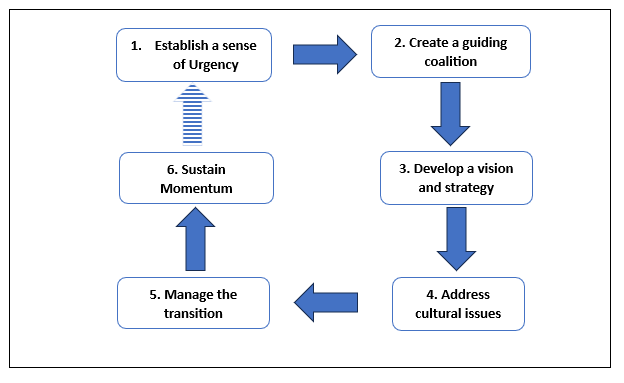Introduction to leaders and change management
Change is all around us, yet some people love change and others do not. Too much change can feel unsettling, chaotic, and tiring. Too little change can feel stagnant and dated. Although there can be the need for stability for periods of time, change is essential to improve and develop services and individuals. It also energises and unites teams. There are different models to explain and guide how to approach and manage change in the workplace. Yet, if you read Kotter’s (1992) paper on his model, you recognise that 50% of change management relates to leadership. The success of a change process is a combination of following a structured approach, and the leader involved.
In this first blog – Part 1 – we will explore models to help to understand the change process. Each are linear with a start and finish to follow.
In the second blog – Part 2 – we will explore non-linear models which help us to understand change.
Bite Size ‘Simple Steps’ (TLDR) – 4 Steps to Implementing Change Management in a Marketing Agency – Read part 2 for the next 4 steps
- Establish a Sense of Urgency
- Explanation: Identify and communicate the need for change to create a sense of urgency among your team. This involves understanding the current state, highlighting potential threats, and emphasizing the benefits of the change.
- Example: A digital marketing agency notices a decline in client retention due to outdated strategies. The leadership team presents data showing the need to adopt innovative digital marketing techniques to stay competitive.
- Create a Guiding Coalition
- Explanation: Form a powerful, influential group of stakeholders and leaders who support the change. This coalition will drive the change effort, providing leadership and direction.
- Example: The agency forms a task force comprising senior marketers, tech experts, and client representatives to lead the transformation towards new marketing strategies.
- Develop a Vision and Strategy
- Explanation: Create a clear vision of the desired future state and develop a strategic plan to achieve it. The vision should be compelling and align with the organization’s goals.
- Example: The task force outlines a vision to become a leader in digital marketing by leveraging data analytics, AI, and personalized content. They develop a step-by-step plan to integrate these technologies.
- Communicate the Vision
- Explanation: Share the vision and strategy with the entire organization. Effective communication ensures everyone understands the change, their role in it, and the benefits it will bring.
- Example: The agency hosts a series of meetings, workshops, and training sessions to explain the new vision, the reasons behind the change, and how it will positively impact the business and employees.
Change management tools to assist leaders develop skills, knowledge, and behaviours
Lewin’s Unfreeze- Change- Refreeze model of change
In its simplest form, Lewin proposed a model in 1951 of change starting with the current state being unfrozen, where old systems, processes and behaviours were left. The change would then be implemented before refreezing or establishing that change.

This model can help us to start to think about describing change processes we are leading or have been involved in, but does it help us to plan a change and bring others along with the change? The model raises more questions than answers such as: What processes, systems and behaviours need to be kept and which should be changed? How do you implement the change? How do you know whether the change has been beneficial?
N-step change models
The N-step change models go further to guide you through a change process, taking you through up to 10 phases (Kanter et al, 1992). The best known is probably Kotter’s (1992) with 8 steps – ‘N’ being number. These models are a significant development on Lewin’s Unfreeze, change and re-freeze model, and can be summarised by 6 steps as per the model below:

Establish a sense of urgency
There needs to be a trigger for change, and these can be numerous. In the early stage, there is usually an equal level of ambivalence, inertia, or lack of awareness to make a change. For this reason, it is important to start with an awareness of where your team are, how ready they are to make changes, and the best approach to take.
During the early days of the Covid pandemic in the UK, the significant majority of clinicians working in hospitals shared a great sense of urgency to prepare for the medically unwell patients expected to arrive at the hospitals. Without such a uniting focus, it can be more challenging to create any urgency and this stage can be supported by working with teams to identify their strengths and weaknesses, and future opportunities and threats.
Create a guiding coalition
Early identification of the key individuals or groups who will support and those who will oppose the change will help. Stakeholder analysis can help here.
Working with people to understand their thoughts and ideas may develop your own ideas. Never assume that any ‘resistance’ is pathological or easy to overcome. Making the time and taking the opportunity to engage and share ideas at this stage will help you and your team.
Develop a vision and strategy
Creating a shared vision with others of the future can really help unite and support progress towards your goals including a change process. By following these first three steps you will already be taking a strategic approach towards change and will have completed strategic analysis and decided on what you are going to do.

Address cultural issues
Culture can make or break a change and is included as a key point to consider and never to underestimate the importance of. Culture is complex and constitutes, like an ice- berg, what you can see above the water – these are the tangible manifestations of the prevailing culture such as policies and plans; what you can see on the surface such as values expressed by people; and, to a greater extent, what you can’t see under the water – the beliefs and normal behaviour within people.
Engaging with your team as part of the change process will not only help to understand the prevailing culture, but also to help to shift it in the direction you want and need it to go.
Manage the transition
During any transition, it can be expected to have varying levels of uncertainty, and varying ability of those involved to let go of the past.
Continued leadership and engagement, listening, evaluation and feedback will assist at this stage.
Sustain Momentum
After all the effort in getting a change off the ground, the final step can be overlooked, and leaders can move on to the next change. However, maintaining any change is important to prevent returning to previous situations.
Again, continue to engage, listen, evaluate, and provide clear feedback.
It is also important to recognise where things aren’t going well, and the change process needs to be stopped or reversed. By having undertaken engagement and evaluation, the information will be available to make an informed decision.
Summary of Change management tools used to assist leaders develop skills, knowledge, and behaviours
Two linear models of change have been presented, with the N-step model a development of Lewin’s Unfreeze-Change-Refreeze model. Although linear to follow, the N-step model is a circular model with the last step of sustaining momentum linking to the beginning of the next change and development.
Change management is a great opportunity to involve and engage with your teams. The models will guide you, but your leadership and approach will make meaningful change happen. Involving others at all stages will help with the outcome of the change.
There is overlap with change management and taking a strategic approach. You can learn more about strategy by reading Strategy in Simple Steps. The book provides an introduction to strategy. It takes you through the tools to use to develop strategy in an easy-to-follow practical approach.
References
Kanter, R.M Stein, B.A and Jick, T.D (1992) The Challenge of Organizational Change, New York, USA, Free Press
Kotter (1996) Successful Change and the force that drives it, The Canadian Manager, Fall 1996, 21, 3, p 20 – 24
Lewin, K.C. (1951) Field Theory in social science. New York, NY: Harper & Row





